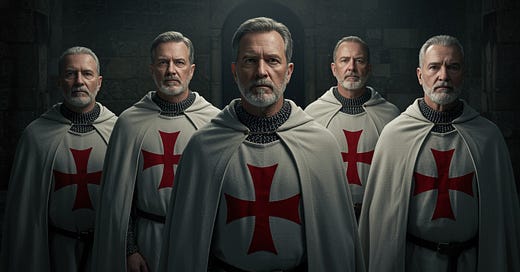Greetings Gold and Silver Level Templar Knights - let’s look at the best and worst of the Templar Grand Masters!
Ranking the Templar Grand Masters from best to worst isn't easy. Some leaders of the order were dealt a poor hand and did the best under impossible conditions. But let's have a go at deciding which masters showed great qualities and who had terrible judgement. We'll start at the top and head downwards - one to five. Best first, worst last.
ONE: Hugh de Payens
Hugh de Payens, along with about nine other knights, formed the Order of the Poor Fellow-Soldiers of Christ and of the Temple of Solomon, better known as the Knights Templar. He served as the first Grand Master, leading the order for nearly two decades.
We don't know the exact thought process that led Hugh to conceive of the Templars but the idea crystallised rapidly and chimed with the zeitgeist. Hugh took the Templars on the road, raising money and support across Europe. He began establishing the network of wealth creating preceptories and together with Saint Bernard of Clairvaux, set down the theological justification for defending Christianity with the sword.
His impact on the crusades was enormous by creating a permanent military force in the Holy Land governed by monastic rules. A celibate, ideologically committed, disciplined force that remained in place all year round.
TWO: Bertrand de Blanchefort
After the revolutionary act of creation, the Templars were blessed with grand masters who were able consolidators. De Blanchefort carried out reforms that ensured the grand masters listened to their subordinates. He wrote the "Retraits", which established clearer roles and protocols for different ranks within the Templar hierarchy, ensuring a more structured and efficient organisation.
Getting captured for three years by the enemy was not a great move, but this was down to bad luck more than incompetence. The Templars' innovative banking system, which involved protecting pilgrims' money and managing large-scale financial transactions, grew significantly during his tenure.
THREE: Guillaume de Sonnac
To lose one eye in battle is unfortunate - but to lose both begins to look careless. One unfortunate day, fighting in Egypt, De Sonnac was blinded in one eye. In the very next battle, he managed to get himself blinded in the other remaining good eye. Staggering around the battlefield, he was an easy target for the Saracens who finished him off.
He was fighting during the Seventh Crusade under the leadership of the French king Louis IX, who would later be canonised as a saint by the church. This crusading force made a heroic attempt to conquer Egypt, which ultimately failed. The fate of De Sonnac, to be blinded by degrees, reminds me of the knight in Monty Python and the Holy Grail who loses one limb after another in a sword fight and insists on carrying on declaring, 'tis but a scratch'.
FOUR: Jacques de Molay
What are we to make of the last Templar grand master? He botched a last opportunity to take Acre and re-establish a foothold on the mainland in the Middle East. De Molay expected support from the Mongols and Christian Europe that failed to materialise. Realising that support for the crusades was declining, he tried to rally support internally. Despite everything, recruitment and donations did continue in these last challenging years. Young men still wanted to be Templars and the pious were prepared to back the order.
However, with zero presence in the Middle East, the Templars were vulnerable to criticism. De Molay flatly rejected a merger with the rival Knights Hospitaller, suggested by the pope. Wagging tongues began posing the question: why are the Templars sitting on so much wealth yet doing nothing in the Holy Land? Started to look stiff-necked and intransigent, De Molay agreed to return to his native France, failing to realise the King, Philip IV, was setting a trap.
When the trap was sprung and the Templars were arrested on charges of sodomy and heresy, De Molay was stunned. Possibly broken by torture, he vacillated during the long legal proceedings against the order. If other knights were expecting courageous leadership under pressure, they were to be disappointed. Tragically, he was burned at the stake in 1314 as a heretic. We're led to belief he cursed the king and pope from the flames but the story is more than likely apocryphal.
FIVE: Gerard de Ridefort
Rash and impetuous or a great military strategist? I trend towards the former view. Despite plenty of sound military advice, De Ridefort led a Templar force at the Battle of Cresson, a precursor to the Battle of Hattin, against a much larger Muslim army. The Templars suffered a devastating defeat, with many knights killed, including the Master of the Hospitallers, Roger de Moulins. Before the battle, De Moulins had counselled avoiding an engagement but De Ridefort taunted him as a coward.
During the subsequent disastrous Battle of Hattin, De Ridefort, after witnessing the defeat, fled the battlefield with a small group of men, leaving his fellow knights to their fate. In the lead up to Hattin, he had got embroiled with factional Christian politics that clouded his judgement and he unwisely took advice from the even more impetuous Raynald of Châtillon.
Raynald was executed by the victorious Saladin after Hattin while the Saracen leader spared De Ridefort on condition he laid down his arms. Of course, he did nothing of the sort. And was later executed by an exasperated Saladin.
If you would like to know more about the Knights Templar, then get your hands on a copy of my book: The Knights Templar – History & Mystery. Published by Pen & Sword and available on Amazon, Waterstones, Barnes & Noble, and WHSmith. Don’t miss out on your copy!







Aloha. I did my genealogy back to Robert de Craon #2 - great uncle, Andre de Montbard #5 - great uncle, Sable #11 - great grandfather, Bernard de Clairvaux co-founder - great uncle, and Raymond de Puy - St John/hospitallers, great uncle. I'm descended from the Anjou Kings, Fulk V etc. Most of the grandmasters don't have their genealogy on geni. They were basically all cousins. Enjoy your blog thanks.